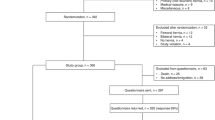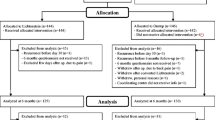Summary
The aim of this prospective study was to evaluate the postoperative pain and disability after treatment of inguinal hernia by the plug technique. Postoperative pain, main organic functions, mobility, return to normal activities and absence from work were prospectively assessed in 118 consecutive patients. Only 3 benign postoperative complications (2.5%) occurred. The mean postoperative pain as assessed by visual analogue scale was 20.3 ± 15.1 mm/100. The mean duration of analgesic consumption was 2.7 ± 1.6 days and the mean total number of capsules was 7.1 ± 4.7. The percentages of patients capable of eating lunch the day of operation, passing urine, walking and bending forward without difficulty 6 hours after operation were 97.5,97.4, 97.5 and 85.6 respectively. The mean postoperative hospital stay was 1.2 ± 0.6 days. The mean times of first outdoor walking, return to normal activities and return to work were 1.5 ± 1, 3.6 ± 2.2 and 15.2 ± 8.9 days respectively. These results show that the plug technique provides a low complication rate, a low level of pain, and allows early resumption of full activity.
Similar content being viewed by others
References
Barkun JS, Wexler MJ, Hinchey EJ, Thibeault D, Meakins JL (1995) Laparoscopic versus open inguinal herniorrhaphy: Preliminary results of a randomized controlled trial. Surgery 118: 703–709
Brooks DC (1994) A prospective comparison of laparoscopic and tension-free open herniorrhaphy. Arch Surg 129: 361–366
Davies N, Thomas M, Me Ilroy B, Kingsnorth AN (1994) Early results with the Lichtenstein tension-free hernia repairs. Br J Surg 81: 1478–1479
Felix EL, Michas CA, Gonzalez MH (1995) Laparoscopic hernioplasty: TAPP vs TEP. Surg Endoscop 3 984–989
Filipi CJ, Gaston-Johansson F, McBride PJ, Murayama K, Gerhardt J, Cornet DA, Lund RJ, Hirai D, Graham R, Patil K, Fitzgibbons R, Gaines RD (1996) An assessment of pain and return to normal activity. Laparoscopic herniorrhaphy vs open tension-free Lichtenstein repair. Surg Endoscop 10: 983–986
Gilbert AI (1992) Sutureless repair of inguinal hernia. Am J Surg 163: 331–335
Godfrey PJ, Greenan J, Ranasinghe DD, Shabes-tary M, Pollock AV (1981) Ventilatory capacity after three methods of anaesthesia for inguinal hernia repair: a randomized controlled trial. Br J Surg 68: 587–589
Goodwin JS, Traverse LW (1995) A prospective cost and outcome comparison of inguinal hernia repairs: Laparoscopic transabdominal preperitoneal versus open tension free preperitonal. Surg Endoscop 9: 981–983
Heikkinen T, Haukipuro K, Leppala J, Hulkko A (1997) Total costs of laparoscopic and Lichtenstein inguinal hernia repairs: Randomized prospective study. Surg Laparoscop Endoscop 7: 1–5
Kozol R, Lange PM, Kosir M, Beleski K, Mason K, Tennenberg S, Kubinec SM, Wilson RF (1997) A prospective, randomized study of open vs laparoscopic inguinal hernia repair. An assessment of postoperative pain. Arch Surg 132: 292–295
Lawrence K, McWhinnie D, Goodwin A, Doll H, Gordon A, Gray A, Britton J, Collin J (1995) Randomised controlled trial of laparoscopic versus open repair of inguinal hernia: Early results. BMJ 311: 981–985
Lichtenstein IL, Manny Shore J (1974) Simplified repair of femoral and recurrent inguinal hernies by a plug technique. Am J Surg 128: 439–444
Lichtenstein IL, Shulman AG, Amid PK, Montllor MM (1989) The tension-free hernioplasty. Am J Surg 157: 188–193
McFadyen BV, Arregui ME, Corbitt JD, et al. (1993) Complications of laparoscopic herniorrhaphy. Surg Endoscop 7: 155–158
Millat B, Fingerhut A, Gignoux M, Hay JM, and the French Associations for Surgical Research (1993) Factors associated with early discharge after inguinal hernia repair in 500 consecutive unselected patients. Br J Surg 80: 1158–1160
Peiper C, Töns C, Shippers E, Busch F, Schumpelick V (1994) Local versus general anesthesia for Shouldice repair of the inguinal hernia. World J Surg 18: 912–916
Phillips EH, Arregui M, Carroll BJ, et al. (1995) Incidence of complications following laparoscopic hernioplasty. Surg Endoscop 9: 16–21
Rutkow IM, Robbins AW (1995) Groin Hernia. In: Cameron JL (ed) Current Surgical Therapy, 5th edn. Mosby Yearbook, St. Louis, pp 481–486
Stoker DL, Spiegelhalter DJ, Singh R, Wellwood JM (1994) Laparoscopic versus open inguinal hernia repair: Randomised prospective trial. Lancet 343: 1243–1245
Teasdale C, McCrum A, Williams NB, Horton RE (1982) Aspects of treatment. A randomized controlled trial to compare local with general anaesthesia for short-stay inguinal hernia repair. Ann R Coll Surg Engl 64: 238–242
Author information
Authors and Affiliations
Rights and permissions
About this article
Cite this article
Pélissier, E.P., Blum, D. The plug method in inguinal hernia: Prospective evaluation of postoperative pain and disability. Hernia 1, 185–189 (1997). https://doi.org/10.1007/BF01234756
Received:
Accepted:
Issue Date:
DOI: https://doi.org/10.1007/BF01234756




